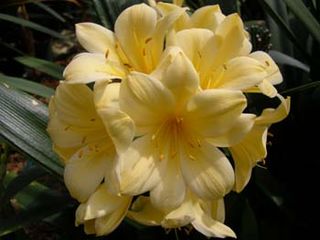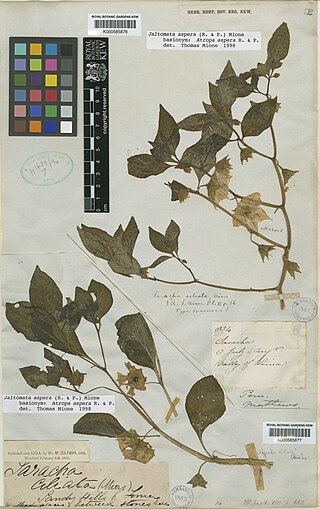
Liliales is an order of monocotyledonous flowering plants in the Angiosperm Phylogeny Group and Angiosperm Phylogeny Web system, within the lilioid monocots. This order of necessity includes the family Liliaceae. The APG III system (2009) places this order in the monocot clade. In APG III, the family Luzuriagaceae is combined with the family Alstroemeriaceae and the family Petermanniaceae is recognized. Both the order Lililiales and the family Liliaceae have had a widely disputed history, with the circumscription varying greatly from one taxonomist to another. Previous members of this order, which at one stage included most monocots with conspicuous tepals and lacking starch in the endosperm are now distributed over three orders, Liliales, Dioscoreales and Asparagales, using predominantly molecular phylogenetics. The newly delimited Liliales is monophyletic, with ten families. Well known plants from the order include Lilium (lily), tulip, the North American wildflower Trillium, and greenbrier.

Victoria or giant waterlily is a genus of aquatic herbs in the plant family Nymphaeaceae. Its leaves have a remarkable size: Victoria boliviana produces leaves up to 3.2 metres (10 ft) in width. The genus name was given in honour of Queen Victoria of the United Kingdom.

Alstroemeria, commonly called the Peruvian lily or lily of the Incas, is a genus of flowering plants in the family Alstroemeriaceae. They are all native to South America, although some have become naturalized in the United States, Mexico, Australia, New Zealand, Madeira and the Canary Islands. Almost all of the species are restricted to one of two distinct centers of diversity: one in central Chile and southern Argentina, the other in eastern Brazil. Species of Alstroemeria from Patagonia are winter-growing plants, while those of Brazil are summer growing. All are long-lived perennials except A. graminea, a diminutive annual from the Atacama Desert of Chile.

Alstroemeriaceae is a family of flowering plants, with 254 known species in four genera, almost entirely native to the Americas, from Central America to southern South America. One species of Luzuriaga occurs in New Zealand, and the genus Drymophila is endemic to south-eastern Australia.

Clivia is a genus of monocot flowering plants native to southern Africa. They are from the family Amaryllidaceae, subfamily Amaryllidoideae. Common names are Natal lily or bush lily.

Trithuria is a genus of small ephemeral aquatic herb that represent the only members of the family Hydatellaceae found in India, Australia, and New Zealand. Almost all described species of Trithuria are found in Australia, with the exception of T. inconspicua and T. konkanensis, from New Zealand and India respectively. Until DNA sequence data and a reinterpretation of morphology proved otherwise, these plants were believed to be monocots related to the grasses (Poaceae). They are unique in being the only plants besides two members of Triuridaceae in which the stamens are centred and surrounded by the pistils; in Hydatellaceae the resulting 'flowers' may instead represent condensed inflorescences or non-flowers.

Tulipa gesneriana, the Didier's tulip or garden tulip, is a species of plant in the lily family, cultivated as an ornamental in many countries because of its large, showy flowers. This tall, late-blooming species has a single blooming flower and linear or broadly lanceolate leaves. This is a complex hybridized neo-species, and can also be called Tulipa × gesneriana. Most of the cultivars of tulip are derived from Tulipa gesneriana. It has become naturalised in parts of central and southern Europe and scattered locations in North America.

Dimorphorchis is a genus of flowering plants from the orchid family, Orchidaceae. It contains 9 species, which are native to Papua New Guinea, the Philippines, Indonesia, Malaysia, Solomon Islands, and Brunei. It is remarkable for its two flower morphs present on the same plant.

Deherainia is a genus of plants in the family Primulaceae, native to Central America.

Jaltomata aspera is a species of flowering plant in the family Solanaceae. It is native to Peru where it grows on rocky hillsides at elevations less than 1800 m.

Jaltomata weberbaueri is a plant species native to Peru. It grows on rocky hillsides at elevations less than 1800 m.

Rauhia is a genus of bulbous, perennial plants in the family Amaryllidaceae endemic to Peru.

Fuchsia procumbens is a prostrate shrub that is endemic to coastal areas of the North Island of New Zealand. Common names include creeping fuchsia, climbing fuchsia or trailing fuchsia.

Hymenocallis acutifolia is a plant species first described in 1826 with the name Hymenocallis littoralis var. acutifolia. It is endemic to Mexico, known from the States of Oaxaca, Michoacán, Jalisco, Veracruz, Puebla, and Nayarit.

Eccremocarpus scaber, the Chilean glory-flower or Chilean glory creeper, is a species of perennial plant in the family Bignoniaceae. It is found in Chile.

Phyllobotryon is a genus of flowering plants belonging to the family Salicaceae native to the region spanning from Nigeria to Tanzania and Angola.

Pamianthe peruviana, also known as the giant Peruvian daffodil, is a species of epiphytic plant native to seasonally dry areas of Peru and Bolivia.

Alstroemerieae is the name of a tribe of monocotyledonous, herbaceous, perennial plants belonging to the Alstroemeriaceae family. They are native to Central and South America. They have very vivid flowers, relatively large and of various colors. Because of the beauty of their flowers, they are often used as ornamental plants and, especially, as cut flowers.

































